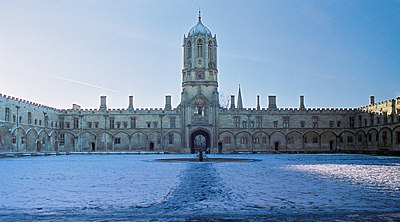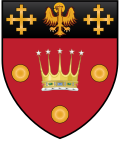Portal:University of Oxford
| Main page | Indices | Projects |
The University of Oxford portal
The University of Oxford is a collegiate research university in Oxford, England. There is evidence of teaching as early as 1096, making it the oldest university in the English-speaking world and the world's second-oldest university in continuous operation. It grew rapidly from 1167, when Henry II banned English students from attending the University of Paris. After disputes between students and Oxford townsfolk in 1209, some academics fled north-east to Cambridge where they established what became the University of Cambridge. The two English ancient universities share many common features and are jointly referred to as Oxbridge.
The University of Oxford is made up of thirty-nine semi-autonomous constituent colleges, four permanent private halls, and a range of academic departments which are organised into four divisions. Each college is a self-governing institution within the university, controlling its own membership and having its own internal structure and activities. All students are members of a college. It does not have a main campus, but its buildings and facilities are scattered throughout the city centre. Undergraduate teaching at Oxford consists of lectures, small-group tutorials at the colleges and halls, seminars, laboratory work and occasionally further tutorials provided by the central university faculties and departments. Postgraduate teaching is provided in a predominantly centralised fashion.
Oxford operates the Ashmolean Museum, the world's oldest university museum; Oxford University Press, the largest university press in the world; and the largest academic library system nationwide. In the fiscal year ending 31 July 2023, the university had a total consolidated income of £2.92 billion, of which £789 million was from research grants and contracts.
Oxford has educated a wide range of notable alumni, including 30 prime ministers of the United Kingdom and many heads of state and government around the world. 73 Nobel Prize laureates, 4 Fields Medalists, and 6 Turing Award winners have matriculated, worked, or held visiting fellowships at the University of Oxford, while its alumni have won 160 Olympic medals. Oxford is the home of numerous scholarships, including the Rhodes Scholarship, one of the oldest international graduate scholarship programmes. (Full article...)
Selected article
The Boat Race, also known as the "University Boat Race" and "The Oxford and Cambridge Boat Race", is a rowing race between Oxford University Boat Club and Cambridge University Boat Club each spring on the River Thames in London. The course (map pictured), which is 4 miles 374 yards long (6,779 metres), runs from Putney to Mortlake, passing Hammersmith and Barnes. The clubs' presidents toss a coin before the race for the right to choose which side of the river (station) they will row on: the north station ("Middlesex") has the advantage of the first and last bends, and the south ("Surrey") station the longer middle bend. Members of both teams are traditionally known as "blues" and each boat as a "Blue Boat", with Cambridge in light blue and Oxford dark blue. The first race was in 1829 and it has been held annually since 1856, with the exception of the two world wars. The 2012 race was won by Cambridge, after an interruption by a protestor swimming across the river into the path of the boats. As of 2014 Cambridge have won the race 81 times and Oxford 78 times, with one dead heat. The event is a popular one, not only with the alumni of the universities, but also with rowers in general and the public. (Full article...)
Selected biography
Selected college or hall
St Stephen's House is a theological college and one of the Permanent Private Halls (PPHs) of the University of Oxford. Unlike the colleges, which are run by their Fellows, PPHs are run by an outside institution – in the case of St Stephen's, the Church of England. It was founded in 1876 by Edward King, Bishop of Lincoln and one of the leading figures in the Tractarian movement, and became a PPH in 2003. It was originally located in the centre of Oxford on the site where the New Bodleian Library now stands, but moved soon afterwards to North Oxford. In 1980, it acquired a site in Iffley Road, East Oxford, that had been vacated by the Society of St. John the Evangelist. The current buildings contain the church of St John the Evangelist, designed by G F Bodley; accommodation is provided on site for married and single students. Part of the Anglo-Catholic tradition of the Church of England, it trains candidates for ordination and accepts other students for qualifications in Theology or Education. Alumni include David Hope (Archbishop of York), Glyn Simon (Archbishop of Wales), Jeffrey John (Dean of St Alban's) and Trevor Mwamba (Bishop of Botswana). (Full article...)
Selected image

Did you know
Articles from Wikipedia's "Did You Know" archives about the university and people associated with it:
- ... that the Australian lamington cake (pictured) is believed to have been named after Charles Cochrane-Baillie, 2nd Baron Lamington, the then-Governor of Queensland?
- ... that William Havard, who was bishop of two Welsh dioceses (St Asaph, then St David's), once represented Wales in an international rugby union match?
- ... that Robert Gentilis graduated from Oxford aged 12 and became a Fellow of All Souls College aged 17, below the minimum fellowship age of 18?
- ... that cricketer Roger Kimpton also won an Oxford University tennis tournament and a golf blue, and was awarded a Distinguished Flying Cross as a Second World War fighter pilot?
- ... that when scholar Spencer Barrett’s tax return was challenged, he showed that to understand a text of Pindar he had to know how Mount Etna had appeared to a passing sailor?
Selected quotation
Selected panorama
Wikimedia
The following Wikimedia Foundation sister projects provide more on this subject:
-
Commons
Free media repository -
Wikibooks
Free textbooks and manuals -
Wikidata
Free knowledge base -
Wikinews
Free-content news -
Wikiquote
Collection of quotations -
Wikisource
Free-content library -
Wikiversity
Free learning tools -
Wikivoyage
Free travel guide -
Wiktionary
Dictionary and thesaurus















